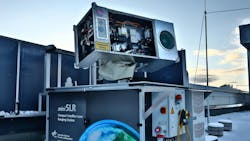DLR develops mobile station for Satellite Laser Ranging
COLOGNE, Germany - Satellite Laser Ranging (SLR) is a very precise, laser-based method for determining the distance between a satellite and Earth with an accuracy of a few millimeters. SLR is primarily used in geodesy. This is because the precise measurement of satellite orbits helps to determine changes in Earth's structure and rotation. The SLR method also makes important contributions in the field of satellite navigation. To date, the systems required for SLR have been large stations. Their construction is complex, and costly and they require several people to operate them. The German Aerospace Center (Deutsches Zentrum für Luft- und Raumfahrt; DLR) has developed a much smaller, mobile version. 'miniSLR' is transportable, easier to set up and maintain and can be operated automatically. This makes it considerably cheaper than the usual SLR systems. The prototype of miniSLR has already delivered measurement data under realistic operating conditions that can compete with large stationary systems, the German Aerospace Center (DLR) reports. Continue reading original article.
The Military & Aerospace Electronics take:
31 January 2024 - The miniSLR system, crafted at the DLR Institute of Technical Physics in Stuttgart, is characterized by its compact, box-shaped design. Fully enclosed and with a weight of around 600 kilograms, it measures 1.8 meters in length, 1.3 meters in width, and two meters in height. Utilizing this system requires only a stable surface along with power and internet connections. Future operations envision the miniSLR functioning autonomously, leading to substantial reductions in station operating costs. Currently, the team is manually overseeing the prototype.
"Miniaturising the main components of miniSLR was a major challenge in the project," explains DLR researcher Wolfgang Riede. He is Head of the Active Optical Systems Department, where the project is based. "To keep the system as small and compact as possible, we use a diode-pumped solid-state laser. It has the necessary power but does not take up as much space. That is a decisive factor because the telescope of the miniSLR is also smaller. Without a powerful laser, we would otherwise not get enough of the laser light back to be able to conduct successful measurements." In large stationary systems, the telescope has a diameter of 50 to 80 centimeters. The DLR system, on the other hand, requires only 20 centimeters. At the same time, the project team estimates that miniSLR can be three to five times less costly than conventional stations. These cost between three and five million euros.
Related: DLR taps Airbus for first-ever in-orbit verification of laser-optical clocks
Related: The promise of laser communications to revolutionize optical links
Jamie Whitney, Senior Editor
Military + Aerospace Electronics
